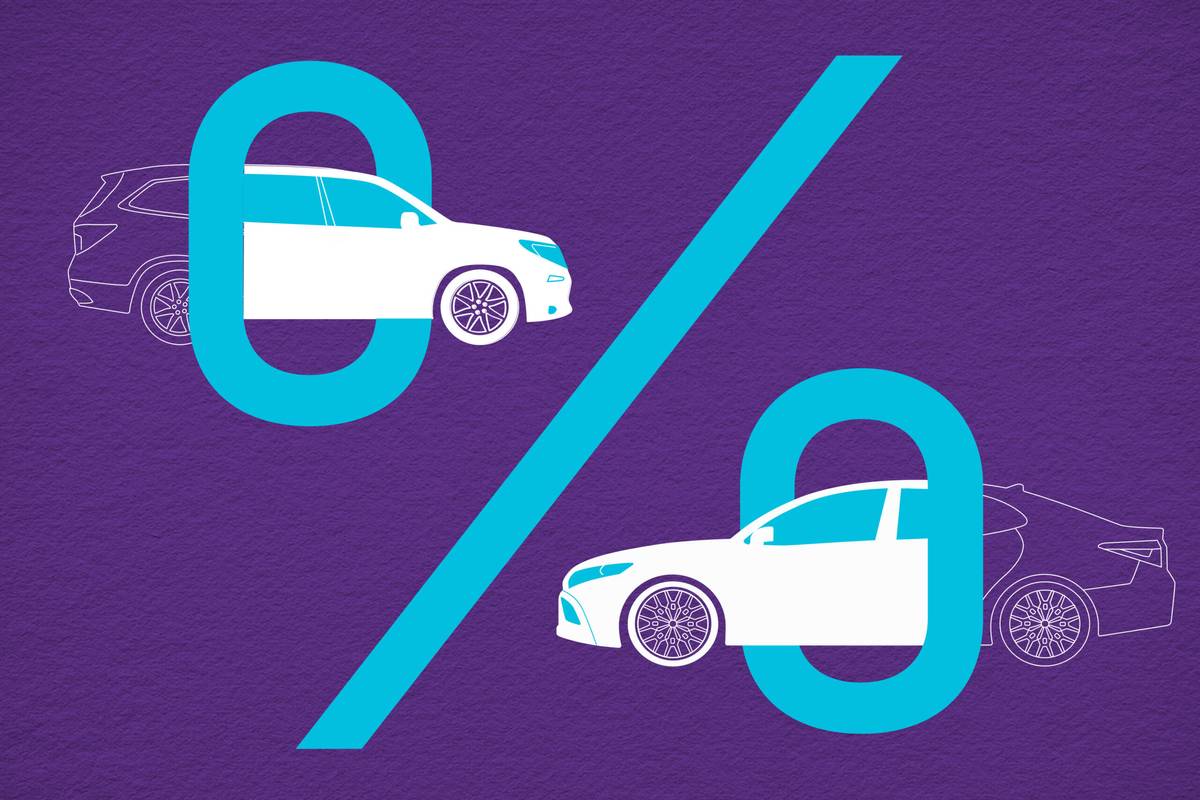Auto Loan Rates Are Surging: What’s a Good Rate Right Now?


Record-high vehicle prices have dominated the headlines in the last couple of years; however, the price listed on the window sticker isn’t the only one that demands attention right now. Not only do new and used cars cost more upfront thanks to the inventory shortage, but the cost to finance a vehicle is also trending up. Financing costs are often an afterthought in the car affordability equation, but a higher interest rate can mean paying thousands of dollars (or even tens of thousands) more over the course of the loan. As interest rates climb, how can shoppers determine if the rate they are offered is good — or at least fair?
Related: Calculate Your Car Loan
Many variables determine auto loan rates, some of which are out of shoppers’ control. For example, rates have climbed substantially following the Federal Reserve’s recent interest-rate hikes, adding to the affordability pinch: Experian’s latest automotive finance report estimates the average new-car loan rate reached 6.07% in the fourth quarter of 2022 — up from 3.88% in the fourth quarter of 2021. Other variables are directly influenced by individual circumstances:
“Interest rates can vary depending on multiple factors, including the size of the loan, the type of vehicle you’re buying, is the vehicle new or used, loan terms, and your credit history, among others,” wrote Melinda Zabritski, Experian’s senior director of automotive financial solutions, in an email to Cars.com. “Based on our [fourth quarter] 2022 data, the average interest rate for a new vehicle was 6.07%, while the average interest rate for a used vehicle was 10.26% — but again this can vary depending on the lender’s criteria.”
Understanding how financing costs vary based on these factors can help shoppers prepare for their vehicle purchase, get the best rate possible and sidestep some of the concerning trends covered below.
Car Loan Rates, Monthly Payments, Delinquencies Up
According to a Cars.com survey of prospective car buyers from January 2023, rising finance costs are making shoppers nervous: 64% of respondents reported worrying about increasing interest rates in 2023, and 60% say they will change their spending habits if the Fed raises interest rates again. This “approach with caution” mentality is supported by data showing monthly car payments, auto debt and delinquencies are all rising in lockstep with higher interest rates.
Experian’s data shows a notable increase in average monthly car payments: The average new-car payment climbed nearly 11% from $646 to $716 between the fourth quarter of 2021 and 2022. Meanwhile, the average used-car payment hit a record high of $526 in the fourth quarter of 2022, up from $490 in 2021.
Higher vehicle prices coupled with rising interest rates have contributed to record-high auto debt in the U.S. Total auto debt reached $1.55 trillion in the fourth quarter of 2022 — an increase of $94 billion from the prior year, according to the Federal Reserve Bank of New York. At the same time, more borrowers are falling behind on their payments: 2.2% were 90 days or more delinquent on their debt in the fourth quarter of 2022, up from 1.6% the prior year.
Average Car Loan Rates by Credit Score
The two variables that heavily influence a shopper’s auto loan rate are their credit score and whether they are buying a new or used car. Experian defines five credit categories based on a range of credit scores: super prime (credit scores of 781-850), prime (661-780), near prime (601-660), subprime (501-600) and deep subprime (300-500). The average loan rate for new-car shoppers who fall into Experian’s top-tier super prime category was 4.75%, 8.12% for the near prime group and 13.42% for the deep subprime category.
Although the super prime category pays significantly less in interest on average, this group also saw the largest increase in interest rates from 2021 to 2022. The average auto loan rate jumped 2.26% for super prime borrowers, but less than 1% for deep subprime borrowers.
Used-vehicle shoppers should also expect to see higher rates across all credit categories. The average rate was 5.99% for super prime borrowers, 12.08% for near prime and 20.62% for deep subprime. Below are the average auto loan rates for new and used cars based on Experian’s credit score categories for the fourth quarter of 2022.
- Super prime: 4.75% (new); 5.99% (used)
- Prime: 5.82%; 7.83%
- Near prime: 8.12%; 12.08%
- Subprime: 10.79%; 17.46%
- Deep subprime: 13.42%; 20.62%
Average Rates by Lender: Automakers, Banks, Credit Unions

Another consideration is where you choose to finance your car because the lender type also impacts the interest rate, though to a lesser extent than your credit score. While many shoppers choose to go the one-stop-shop route and get a loan through a dealership’s finance and insurance department, it’s a good idea to consider all the options. Experian found that the lowest average rate for new vehicle loans was offered by captive finance (an automaker’s in-house financing arm) followed by credit unions. Meanwhile, credit unions offered the best rates for used cars.
Here are the average rates by lender type for new and used cars for the fourth quarter of 2022:
- Captive finance: 5.45% (new); 9.25% (used)
- Credit unions: 5.49%; 7.03%
- Buy Here Pay Here/other: 6.06%; 11.20%
- Banks: 7%; 9.34%
- Finance companies: 9.38%; 19.17%
“It’s recommended that consumers shop around for the best interest rates. However, during the fourth quarter of 2022, captives and credit unions offered the lowest average interest rates for new vehicles at 5.45% and 5.49%, respectively,” noted Zabritski. “With respect to the used vehicle market, credit unions offered the lowest average interest rate at 7.03%; the next closest was captives at 9.25%. Keep in mind, dealers also have relationships with different lenders, and can often generate lower interest rates than consumers going directly to their lender.”
Car shoppers seem to be seeking out competitive rates: The total loan market share of credit union lenders for new-car financing overtook banks and captive finance companies last year, climbing from approximately 23% of all auto loans financed in 2021 to 29% in 2022. Meanwhile, banks saw the biggest drop, falling from 35% to 27% in the same period.
“Perhaps the single, largest factor contributing to credit unions’ increased market share was low interest rates,” added Zabritski. “While credit unions have historically focused on the used vehicle market, offering low interest rates on new vehicles opened up more opportunity overall.”
What Does This Mean for My Car Loan?
The difference in the overall cost to finance a new car with the top- and bottom-tier credit categories is significant: Financing a $35,000 vehicle for 60 months at an average rate of 13.42%, a deep subprime shopper can expect to pay a total of $13,234 in interest, according to Investopedia’s calculator. Meanwhile, a shopper with a credit score in the super prime category (average rate of 4.75%) will be looking at approximately $4,390 in interest under the same conditions — a difference of $8,844.
Another scenario to consider is the cost of financing a $35,000 used car for 60 months as a deep subprime or super prime borrower. The latter will pay approximately $5,589 over the course of the loan with an average rate of 5.99%, while a deep subprime shopper will pay $21,364 with a 20.62% average rate — a difference of $15,775.
Finally, we calculate the average cost to finance a new and used car through the most popular lender types: credit unions, banks and captive finance. The following total interest costs are estimated based on the average rate by the lender type: Financing a $35,000 new car for 60 months will cost approximately $5,064 with captive finance, $5,103 with a credit union and $6,583 with a bank. For a used vehicle with the same finance amount and term length, the total interest cost is approximately $6,612 with a credit union, $8,848 with captive finance and $8,940 with a bank.
How to Get the Best Car Loan Rate

Along with federal interest rates, credit score, and the vehicle and lender type, the loan’s term length and loan-to-value ratio also play a role in interest rate offers.
Avoid Long-Term Loans, Reduce the Loan Amount
Long-term auto loans have become more common as shoppers attempt to keep their monthly payments down -– Experian’s data shows the average loan term for used vehicles increased from 65.66 months in 2020 to 68.01 months in 2022. Among new-car shoppers, those with deep subprime and subprime credit had significantly higher average loan terms of 73.01 and 74.02 months, respectively, compared to the super prime group’s average of 63.81 months.
While lower payments stretched over a longer time period seem beneficial in the short term, long-term loans have drawbacks like higher total interest costs and a greater chance of becoming upside down on the loan, meaning you owe more for the car than it’s worth.
According to the Consumer Financial Protection Bureau, a vehicle’s loan-to-value ratio is the total dollar value of the loan divided by the actual cash value of the vehicle. Because the vehicle becomes collateral for the loan, a lower loan-to-value ratio may yield a more favorable interest rate since there is less risk for the lender. The best way to lower the ratio is a down payment to reduce the total loan amount.
Know Your Credit Score, Get Preapproved
Since a shopper’s credit score and lender type can have a significant impact on the interest rate offer, knowing your credit score and working to improve it prior to the purchase can yield a lower interest rate and a less costly car loan. Getting preapproved is another strategy that can help you save on financing costs; this allows you to shop for the best loan terms among various lenders. While preapproval can benefit all car shoppers, it is especially useful for those that fall into the lower credit score categories.
“Beyond shopping for the best interest rates and loan terms, we always recommend consumers review their credit report prior to heading into the showroom — that way consumers know what loan terms they could expect to receive,” Zabritski advised. “If possible, consumers should pay down any debt. In addition, have an honest conversation about the vehicles that fit within their budget — consumers do not want to overextend themselves.”
More From Cars.com:
- What Credit Score Do You Need for a Car Loan?
- How to Calculate a Car Payment
- Can You Get a Car Loan With Bad Credit?
- How to Win the Car Financing Game
- More Car Financing Advice
Cars.com’s Editorial department is your source for automotive news and reviews. In line with Cars.com’s long-standing ethics policy, editors and reviewers don’t accept gifts or free trips from automakers. The Editorial department is independent of Cars.com’s advertising, sales and sponsored content departments.

Former News Editor Jane Ulitskaya joined the Cars.com team in 2021, and her areas of focus included researching and reporting on vehicle pricing, inventory and auto finance trends.
Featured stories




